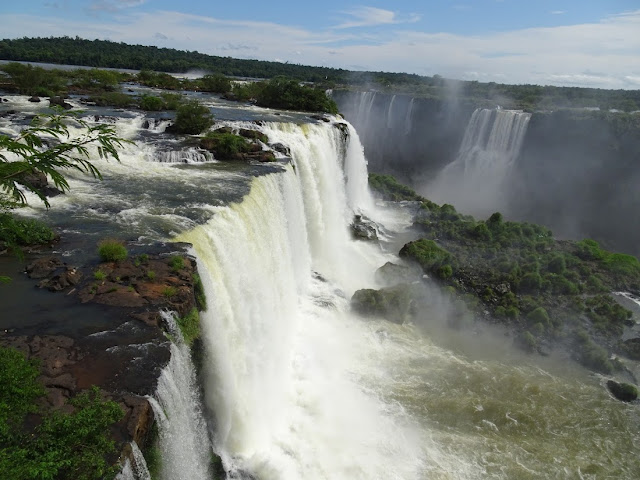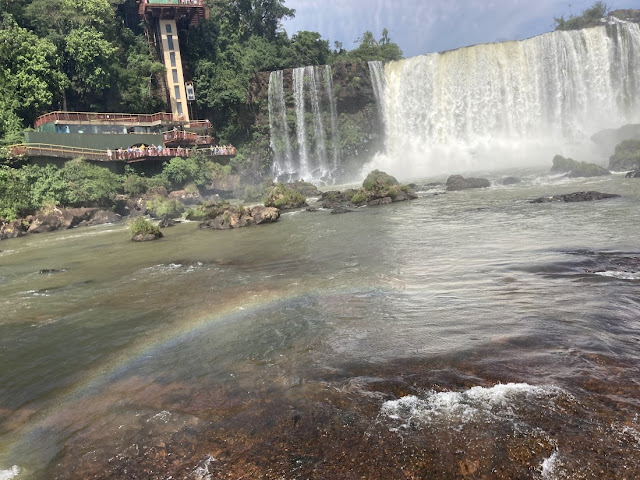Our guide, Ijnacia, met us upon arrival and we were off to Brazil to see Iguazu Falls. After crossing the border and clearing customs, it started to rain - a lot! We hadn't had lunch yet, so Ijnacia suggested we stop inside the national park at a buffet restaurant. The food was tasty with a wide variety of choices including rice and beans, stewed chicken, some cooked beef chunks, vegetables and salads. Fortunately, it stopped raining during lunch, so we had a dry visit to the falls (except for the spray)!
So what is the big deal about Iguazu Falls? Let me give you a little history and some facts, then I will overload you with pictures!
Iguazu Falls are a set of many waterfalls located on the Iguazu River on the border between the Argentine province of Misiones and the Brazilian state of Parana. Argentina's landscape architect, Carlos Thays visited the falls with the mission of the Ministry of the Interior to organize the first national park project in the country that would safeguard the beauty of the falls and surrounding jungle. The Iguazu National Park was created in 1934, modeled after Yellowstone National Park in the USA, to conserve the biodiversity and environment of the falls. There is even a beautiful hotel built in the park that reminded us a little of the historic Yellowstone Hotel. The National Reserve was created in 1970 the protected area of Iguazu National park was designated as one of the New Seven Natural Wonders of the World by UNESCO in 1984.
The great power of the Falls was not utilized until the huge Itaipu hydroelectric power plant was built jointly by Paraguay and Brazil which was complete in 1991. The dam is touted as a masterpiece of technology and is one of the largest in the world. It provides nearly 40% of the power to Brazil and Argentina! On average, about 396,000 gallons of water flows every second! Depending on the time of year, the rate of water flow can be as much as 3,435,000 gallons per second - enough to fill five Olympic swimming pools EVERY SECOND! This is especially true druing the rainy months of November to March.
Iguazu Falls span 1.7 miles long across the Iguazu River. The river is named after the indegenous term for "great water" and forms a large bend in the shape of a horseshoe.There are 275 waterfalls, of which 80% are located on the Argentine side. The highest flow area is known as La Garganta del Diablo (The Devil's Throat) and is located on the Brazilian side. Devil's Throat is 269 feet and is the tallest drop across the falls.
After paying our entrance fee (about $16USD each) we took a shuttle bus halfway into the park, then followed paved trails all the way to the falls.


This was our first view of the falls.


 First views of the Devil's Throat.
First views of the Devil's Throat.
You can click on the link below to see (and hear) the falls.
We were there!
Tower on Brazil side overlooking falls.

Hotel Das Cataratas

As we walked, we spotted different wildlife and vegetation. There was an egret on the river.

This is a "false" pineapple, more correctly known as "Ananas macrodones". It is in the Bromeliaceae family.

 There were several of these small lizards all over the park.
There were several of these small lizards all over the park.



Tower on Brazil side overlooking falls.

Hotel Das Cataratas

As we walked, we spotted different wildlife and vegetation. There was an egret on the river.

This is a "false" pineapple, more correctly known as "Ananas macrodones". It is in the Bromeliaceae family.

 There were several of these small lizards all over the park.
There were several of these small lizards all over the park.

We had never seen butterfly pupas on trees, but they were here, as well as butterflies.




After boarding our bus back to the entrance, we stopped to see a red brocket deer that had crossed the road in front of us. The picture isn't great because the bus was moving, through the window, with the sun in our face. Oh well, we got to see it!

Our drive back to Iguazu City in Argentina was interesting. We crossed the border again and there was so much traffic! People from Brazil and Paraguay come across the border to shop and get gas in their cars because it is so much cheaper. It's about $150 pesos/liter so if you do the math, it's about $1.72 USD per gallon. Oh, those were the days!!!
Anyway, it took over an hour to arrive at our hotel so it was after 7:30 before we headed out to have dinner! We ate at Aqua and shared a fish dinner and salad. It's was lovely, but almost 10pm before we got back and got ready for bed. We have another "early" (for us) morning tomorrow - 8:15 pick up for our tour to the Argetine side of the Falls.




After boarding our bus back to the entrance, we stopped to see a red brocket deer that had crossed the road in front of us. The picture isn't great because the bus was moving, through the window, with the sun in our face. Oh well, we got to see it!

Our drive back to Iguazu City in Argentina was interesting. We crossed the border again and there was so much traffic! People from Brazil and Paraguay come across the border to shop and get gas in their cars because it is so much cheaper. It's about $150 pesos/liter so if you do the math, it's about $1.72 USD per gallon. Oh, those were the days!!!
Anyway, it took over an hour to arrive at our hotel so it was after 7:30 before we headed out to have dinner! We ate at Aqua and shared a fish dinner and salad. It's was lovely, but almost 10pm before we got back and got ready for bed. We have another "early" (for us) morning tomorrow - 8:15 pick up for our tour to the Argetine side of the Falls.









1 comment:
What awesome falls! May have to put it on my bucket list.
Post a Comment